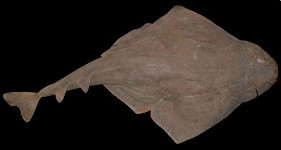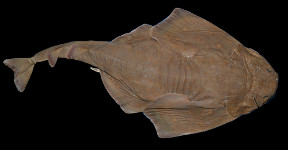Squatina varii
Vaz & De Carvalho, 2018
Classification: Elasmobranchii Squatiniformes Squatinidae
Reference of the original description
New Species of Squatina (Squatiniformes: Squatinidae) from Brazil, with Comments on the Taxonomy of Angel Sharks from the Central and Northwestern Atlantic. Copeia, 106(1), 144–160
New Species of Squatina (Squatiniformes: Squatinidae) from Brazil, with Comments on the Taxonomy of Angel Sharks from the Central and Northwestern Atlantic. Copeia, 106(1), 144–160
Types
Squatina varii
Paratype: MNRJ: 43106; MNRJ: 30190; MNRJ: 30191; MNRJ: 43100; MNRJ: 43101; MNRJ: 43102; MNRJ: 43103; MNRJ: 43105; MNRJ: 43107; MNRJ: 43108; MNRJ: 43109; MNRJ: 43110; MNRJ: 43111; MNRJ: 43112;
Squatina varii
Paratype: MNRJ: 43106; MNRJ: 30190; MNRJ: 30191; MNRJ: 43100; MNRJ: 43101; MNRJ: 43102; MNRJ: 43103; MNRJ: 43105; MNRJ: 43107; MNRJ: 43108; MNRJ: 43109; MNRJ: 43110; MNRJ: 43111; MNRJ: 43112;
Description :
Citation: Squatina varii Vaz & De Carvalho, 2018: In: Database of modern sharks, rays and chimaeras, www.shark-references.com, World Wide Web electronic publication, Version 01/2026
Please send your images of "Squatina varii" to info@shark-references.com

Squatina varii Vaz & De Carvalho, 2018; paratype, adult female, MNRJ 43105 © Diego F. B. Vaz

Squatina varii Vaz & De Carvalho, 2018; paratype, adult female, MNRJ 43105 © Diego F. B. Vaz
Common names
 Vari's Angel Shark
Vari's Angel Shark
 Vari's Angel Shark
Vari's Angel Shark
Short Description
Original diagnosis after VAZ & DE CARVALHO, 2018 [26085]: Squatina varii is distinguished from all western Atlantic congeners (with exception of S. david) by a higher number of vertebral centra, from 138 to 150 (vs. 132–136 in S. argentina; 128–136 in S. guggenheim; 127–136 in S. occulta; 130–135 in S. dumeril; 121 in Squatina sp. NW1). Squatina varii differs from all Southwestern Atlantic species and S. david in their dorsal coloration, which has very few (,20) or lacks white circular spots (vs. dorsal surface of the skin having hundreds of white spots in S. argentina, S. occulta, S. david, and S. guggenheim). Squatina varii is further distinguished from S. argentina, S. guggenheim, and S. occulta by having a wide and semielliptical lobe projecting from the proximal third of the lateral dermal fold of the head (vs. lateral dermal head folds entirely straight or slightly convex, without any emargination in S. argentina, S. guggenheim, and S. occulta). From S. dumeril and S. david, S. varii differs by lacking black blotches on the dorsal surface of the pectoral origin (vs. pectoral origin with rounded black blotches in S. dumeril and S. david). Additionally, S. varii is separated from S. guggenheim and Squatina sp. NW1 by dermal denticles organized in an indistinct row on the dorsal mid-line, which are morphologically similar to remaining trunk denticles, with pyramidal crowns supporting four to five ridges on the anterior surface, and basal plate width approximately 1.2 times basal plate width of trunk denticles (vs. conical and enlarged dermal denticles distinctly organized in a row, with smooth apex and crown, and five to ten vertical ridges medially positioned on the anterior margin of the crown; width of basal plate three to four times wider than the surrounding trunk denticles in S. guggenheim and Squatina sp. NW1). Squatina varii is further separated from S. guggenheim and S. occulta by having two functional ovaries (vs. one functional ovary in S. occulta and S. guggenheim). Additionally, when any white spot is present in the dorsal surface of S. varii, it lacks black spots surrounding it (in contrast to black spots surrounding the white spots in S. occulta). Squatina varii is further distinguished from S. guggenheim by the slit shape of the pseudopera (vs. drop-shaped aperture in S. guggenheim), and by males reaching maturity at 980 mm TL (in contrast to male maturity ranging from 730–800 mm TL in S. guggenheim). The accessory dorsal marginal cartilage of the clasper of S. varii is trapezoidal in shape (vs. rectangular in S. guggenheim) and is positioned in the clasper shaft, laterally in relation to the dorsal marginal cartilage (vs. dorsal marginal cartilage positioned in the clasper glans, posterior to the dorsal marginal cartilage in S. guggenheim). Squatina varii is additionally distinguished from S. argentina by a pair of fully developed enlarged and conical dermal denticles between the spiracles (vs. intraspiracular region covered by small and pyramidal denticles, without enlarged dermal denticles in S. argentina), by lower counts of tooth rows, ranging from 16–20 vertical rows (tooth formula 8þ8 to 10þ9/8þ8 to 10þ10 vs. 12þ12/12þ12 in S. argentina), and by a longer pectoral-fin anterior margin, 28.9–30.9% TL (vs. 25.2– 27.2% TL in S. argentina).
Original diagnosis after VAZ & DE CARVALHO, 2018 [26085]: Squatina varii is distinguished from all western Atlantic congeners (with exception of S. david) by a higher number of vertebral centra, from 138 to 150 (vs. 132–136 in S. argentina; 128–136 in S. guggenheim; 127–136 in S. occulta; 130–135 in S. dumeril; 121 in Squatina sp. NW1). Squatina varii differs from all Southwestern Atlantic species and S. david in their dorsal coloration, which has very few (,20) or lacks white circular spots (vs. dorsal surface of the skin having hundreds of white spots in S. argentina, S. occulta, S. david, and S. guggenheim). Squatina varii is further distinguished from S. argentina, S. guggenheim, and S. occulta by having a wide and semielliptical lobe projecting from the proximal third of the lateral dermal fold of the head (vs. lateral dermal head folds entirely straight or slightly convex, without any emargination in S. argentina, S. guggenheim, and S. occulta). From S. dumeril and S. david, S. varii differs by lacking black blotches on the dorsal surface of the pectoral origin (vs. pectoral origin with rounded black blotches in S. dumeril and S. david). Additionally, S. varii is separated from S. guggenheim and Squatina sp. NW1 by dermal denticles organized in an indistinct row on the dorsal mid-line, which are morphologically similar to remaining trunk denticles, with pyramidal crowns supporting four to five ridges on the anterior surface, and basal plate width approximately 1.2 times basal plate width of trunk denticles (vs. conical and enlarged dermal denticles distinctly organized in a row, with smooth apex and crown, and five to ten vertical ridges medially positioned on the anterior margin of the crown; width of basal plate three to four times wider than the surrounding trunk denticles in S. guggenheim and Squatina sp. NW1). Squatina varii is further separated from S. guggenheim and S. occulta by having two functional ovaries (vs. one functional ovary in S. occulta and S. guggenheim). Additionally, when any white spot is present in the dorsal surface of S. varii, it lacks black spots surrounding it (in contrast to black spots surrounding the white spots in S. occulta). Squatina varii is further distinguished from S. guggenheim by the slit shape of the pseudopera (vs. drop-shaped aperture in S. guggenheim), and by males reaching maturity at 980 mm TL (in contrast to male maturity ranging from 730–800 mm TL in S. guggenheim). The accessory dorsal marginal cartilage of the clasper of S. varii is trapezoidal in shape (vs. rectangular in S. guggenheim) and is positioned in the clasper shaft, laterally in relation to the dorsal marginal cartilage (vs. dorsal marginal cartilage positioned in the clasper glans, posterior to the dorsal marginal cartilage in S. guggenheim). Squatina varii is additionally distinguished from S. argentina by a pair of fully developed enlarged and conical dermal denticles between the spiracles (vs. intraspiracular region covered by small and pyramidal denticles, without enlarged dermal denticles in S. argentina), by lower counts of tooth rows, ranging from 16–20 vertical rows (tooth formula 8þ8 to 10þ9/8þ8 to 10þ10 vs. 12þ12/12þ12 in S. argentina), and by a longer pectoral-fin anterior margin, 28.9–30.9% TL (vs. 25.2– 27.2% TL in S. argentina).
Distribution
Along the continental slope of the Southwestern Atlantic from Sergipe state (11°14'23''S) to northern Rio de Janeiro state (21°23'57''S)[26085]
Along the continental slope of the Southwestern Atlantic from Sergipe state (11°14'23''S) to northern Rio de Janeiro state (21°23'57''S)[26085]
Size / Weight / Age
TL max. male: 1215 mm, TL max female: 1320 mm TL
TL max. male: 1215 mm, TL max female: 1320 mm TL
Dentition
Small gradient monognathic heterodonty (Compagno, 1988). Upper jaw teeth relatively smaller than lower jaw teeth. Upper teeth from fourth to seventh rows approximately 1.5 times larger than those on the first three medial upper vertical rows. On lower jaw, teeth of medial and central vertical rows similar in size. In both upper and lower jaws, teeth of distalmost rows approximately one-half size of teeth on central rows. Upper and lower jaws with 16–20 tooth rows (tooth formula: 8þ8 to 10þ9/8þ8 to 10þ10). Tooth rows arranged without lateral overlapping (independent dentition of Strasburg, 1963). Tooth morphology similar to other species of Squatina from Southwestern Atlantic (Vaz and Carvalho, 2013), with bulky triangular main cusp slanting lingually, without serrations and accessory cusplets. Crown base laterally expanded with prominent lateral heels. [26085]
Small gradient monognathic heterodonty (Compagno, 1988). Upper jaw teeth relatively smaller than lower jaw teeth. Upper teeth from fourth to seventh rows approximately 1.5 times larger than those on the first three medial upper vertical rows. On lower jaw, teeth of medial and central vertical rows similar in size. In both upper and lower jaws, teeth of distalmost rows approximately one-half size of teeth on central rows. Upper and lower jaws with 16–20 tooth rows (tooth formula: 8þ8 to 10þ9/8þ8 to 10þ10). Tooth rows arranged without lateral overlapping (independent dentition of Strasburg, 1963). Tooth morphology similar to other species of Squatina from Southwestern Atlantic (Vaz and Carvalho, 2013), with bulky triangular main cusp slanting lingually, without serrations and accessory cusplets. Crown base laterally expanded with prominent lateral heels. [26085]
Remarks
shark-references Species-ID=15008;
shark-references Species-ID=15008;


















